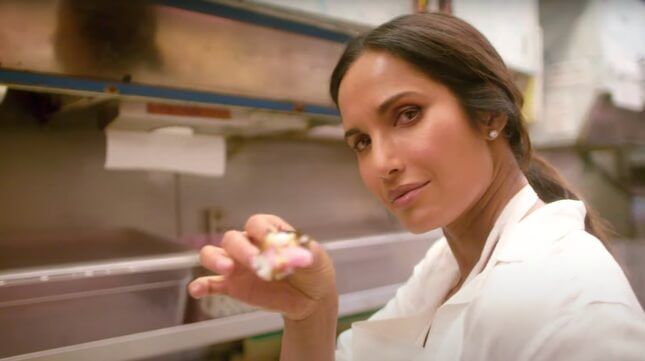

Expanding the definition of what American food is, outside of the hot dog-hamburger-apple pie trifecta, is a never-ending task with no clear answer. The argument that a truly American food that exists outside of any extant immigrant influences is a tricky one to make, but the food that Americans now think of as classically American really did come from elsewhere. Padma Lakshmi’s latest endeavor, Taste the Nation (now streaming on Hulu), attempts to excavate the meaning of American food and in the process, makes an uneven argument in favor of assimilation.
Most mainstream food television programs focus on palatability: making foreign food familiar and non-threatening to a white audience. As writer Alicia Kennedy succinctly pointed out, one of the flaws of Taste the Nation is that it subscribes to an assimilationist thinking that flattens the food it should elevate. Each episode uses a prototypical dish that one might think of as traditionally from another culture—chop suey, fry bread, burritos—as a way to explore how the foods people now take for granted as being roughly American came to be.
The focus of the 10 episodes is not what makes the cultures and cuisines featured extraordinary but rather quite the opposite. By exploring why some foods from other places resonate in America, the examples she provides are extremely, well, American: chop suey, burritos, hot dogs, kebabs, and poke are all items that are American enough to be found at a mall food court. And the fact that a burrito is available at any airport in the U.S. is a testament to its acceptance by white America. But focusing on those familiar foods in particular, as Lakshmi does in the first episode, unwittingly draws attention away from other, lesser-known dishes that are potentially much more interesting and worthy of exploration.
Unlike other shows like Salt, Fat, Acid, Heat and Somewhere South, which center both the foodways and their creators, Taste the Nation functions more as a general news interest show, using food as the way into larger discussions about immigration, but pushing the melting pot theory forward. The series is neither prescriptive nor particularly instructive, but it does come off as a little preachy at times. Each culture highlighted is part of immigrant culture, but Lakshmi’s natural charisma carries each episode, which makes the show watchable enough. But it’s clear that her intention isn’t to convert viewers to a different way of thinking about the palatably so-called ethnic food that they eat but to act as a gatekeeper for a liberal, forward-thinking audience that simply wants to feel good about the choices they make without further interrogation.
LAKSHMI’S CURIOSITY ABOUT THE FOOD SHE’S INTERROGATING FEELS GENUINE, BUT THE EXECUTION IS A LITTLE OFF.
“I think that everything the American cuisines is today is because of what the different cultures have brought to it,” she says in one episode. This statement is correct and also obvious. Instead of highlighting the lesser-known foods that could become entries in American cuisine by dint of exposure, her focus is largely to demonstrate how smoothly the existing culinary landscape has absorbed these iconic dishes. The inability to define what American food actually is is not the fault of Lakshmi or her television program, but it is intrinsically tied to the definition of America itself—fuzzy, ever-evolving, and impossible to pin down. American food should be food that is made by an American, regardless of their country of origin. American food is apple pie and hot dogs, but the mainstream acceptance of things like tacos and poke means that there’s room for other dishes to enter the lexicon.
Each episode of Taste the Nation functions as both history and civics lesson; Lakshmi inherently understands that food is political and so viewed through that lens, this show makes sense for a general, foodie-adjacent audience. But some of the more irksome cooking-cum-travel-show affectations remain, like in the fourth episode, which finds Lakshmi watching San Francisco chef Brandon Jew, proprietor of Michelin-starred restaurant Mister Jiu’s, cook a pared-down, beautifully fresh chop suey in a tent erected somewhere on Shao Shan Farms in Marin, California. Interspersed between pat history lessons and B-roll of Lakshmi blowing a kiss at the camera are shots of farmers and home cooks thrusting a sandwich or a glistening head of lettuce into the camera’s focus, beaming with pleasure. The show lacks the quiet self-assuredness of a Netflix offering, and the pacing is less considered than that of PBS’s food TV programming, which is a function of its platform and not necessarily the content.
Lakshmi’s curiosity about the food she’s interrogating feels genuine, but the execution is a little off; in the episode featuring chop suey, a distinctly Americanized version of Chinese food, comedian Ali Wong leads Lakshmi around San Francisco’s Chinatown, appearing only on the show ostensibly because she is from the Bay Area and also likes to eat. Repeatedly throughout this episode, Lakshmi asks Wong and the other guests she’s found what chop suey is. Predictably, no one has an answer, which proves the point that it is an invention catered towards American palates. Focusing on different interpretations of chop suey or kebabs, as she does in an episode halfway through the series, is a way of trying to understand why these specific foods are a part of American cuisine, but there’s no real attempt to reckon with what that means or why we should be considering other options.